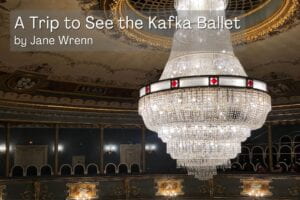
By Jane Wrenn
A couple friends and I traveled one Friday night to the Estates theater to see the Kafka ballet; as we are all in the class ‘Kafka and his Contexts’ and are here at NYU Prague, it felt fitting. Walking in, we marveled at the towering columns and the gorgeous baroque interior. I was shocked that our tickets to such a classy establishment were equivalent to only about 13 American dollars.
We enjoyed a glass of Prosecco (we were at the ballet after all!), discussed how fancy we were, and thought about how Mozart debuted Don Giovanni in that very building. I felt so lucky to walk around halls that held so much history. After finishing our drinks, we walked all the way up to the top floor and all the way to the left to take our seats. At this point I began to understand why our tickets were so cheap; our view was mainly of the top of the ballerinas’ heads. As I had booked the tickets, I felt responsible for our less than ideal view; however, my classmates assured me that they preferred to ‘ball on a budget.’
The ballet began and, despite the awkward angle, it was an incredible experience. Mauro Bigonzetti’s choreography was jarring and disturbing, but beautiful; the piece is such an inventive reimagining of Kafka’s novel The Trial. Ondřej Vinklát played Josef K., the protagonist, a man accused of a crime he did not commit, who is then persecuted by a mysterious, bureaucratic machine. The ballet interpreted Josef K.’s initial arrest, hearings, and various romantic encounters through modern dance.
Instead of a traditional set, projectors were used to create a black and white moving background. The background seemed to nod to the Musée d’Orsay in Paris, which Orson Welles used as the set for his film adaptation of the same story, although I couldn’t say for sure.
Bigonzetti also added an additional character, meant to symbolize the trial itself – a woman wearing a sparkling headpiece and a dress made of newspapers, dragging an antique suitcase behind her filled with papers (I like to think they were pages from the book). The final scene of the ballet was this woman burying Josef K. alive in piles of paper.
The ballet was disturbing; I left feeling like I needed a shower, which is exactly what I would have wanted from a Kafka ballet. It was really exciting to see someone take this work from more than 100 years ago and modernize it. We left excitedly chatting about the ballet, the book and how beautiful the venue was, although our necks were a little sore from craning over the edge of the railing. It was so rewarding to see a Kafka-inspired ballet in the city that inspired Kafka; I would highly recommend it!

